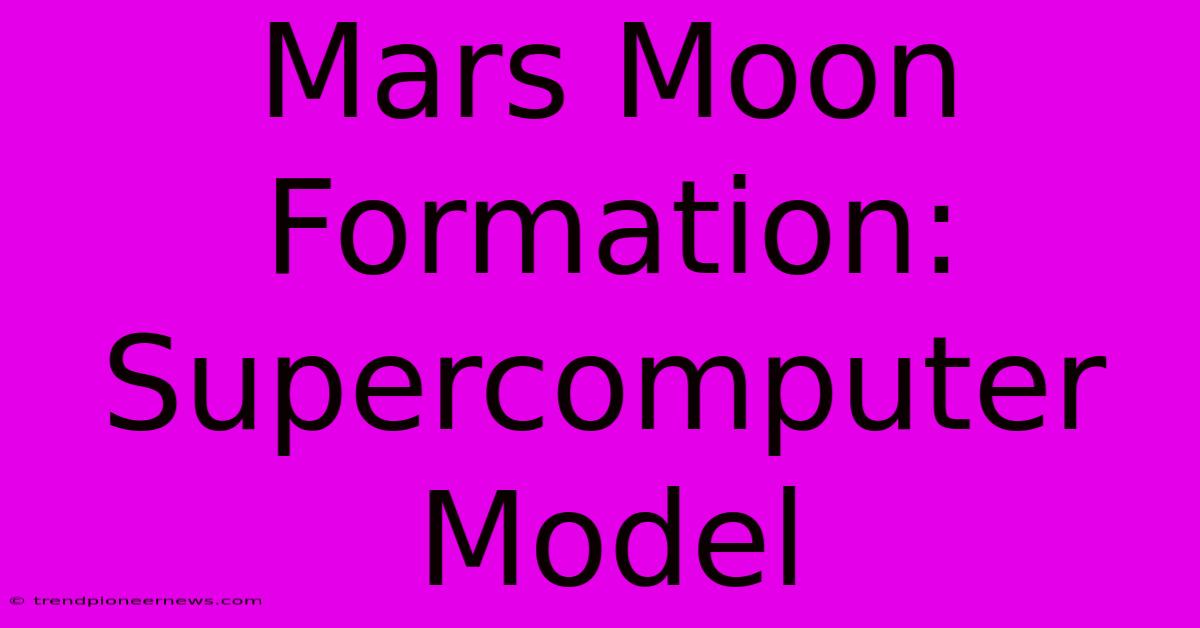Mars Moon Formation: Supercomputer Model

Discover more detailed and exciting information on our website. Click the link below to start your adventure: Visit Best Website Mars Moon Formation: Supercomputer Model. Don't miss out!
Table of Contents
Unlocking the Secrets of Phobos and Deimos: A Supercomputer's Look at Mars' Moons
Hey everyone! So, I've always been fascinated by space, right? Like, seriously fascinated. And lately, I've been diving deep into the mystery surrounding Mars' moons, Phobos and Deimos. They're, like, weird, you know? Tiny, potato-shaped things orbiting the Red Planet. It's always bugged me – how did they get there?
The Usual Suspects: Capture vs. Formation
For ages, scientists have tossed around two main ideas. One is capture. Basically, Mars just snagged these little guys as they wandered through the solar system. Think of it like a cosmic game of pool, except the cue ball is Mars and the 8-ball is…well, Phobos and Deimos.
The other theory is co-formation. This means Phobos and Deimos formed alongside Mars, billions of years ago, from the same swirling disk of gas and dust. Kinda like siblings, but, you know, space siblings.
But here’s the thing – neither theory perfectly explains everything. There are inconsistencies, loose ends… the whole shebang. That's where the supercomputers come in!
Enter the Supercomputer: Simulating Billions of Years
Recently, I read about this amazing study. Scientists used a supercomputer – a seriously powerful machine – to run simulations of the early solar system. They wanted to see if they could recreate the conditions that might have led to the formation of Phobos and Deimos. It was basically a high-tech, digital time machine. I mean, the sheer amount of processing power involved… mind-blowing!
These simulations involved modeling things like gravitational interactions, collisions, and the overall dynamics of the early solar system. They tweaked variables – changing initial conditions, asteroid impact frequencies, you name it – to see which scenarios best matched what we observe today about Phobos and Deimos. The sheer volume of data generated must have been epic!
The Results: A New Twist on an Old Mystery
And what did the supercomputer reveal? Well, the results weren't a simple "yes" or "no" to either theory. It seems that the formation of Mars' moons might be more complicated than we initially thought. The best-fitting models often involved a combination of factors; and yes, a whole heap of collisions and maybe even some capture processes.
The scientists found that a series of gigantic impacts on Mars, early in its history, could have ejected vast amounts of material into orbit. This material, over time, might have gradually clumped together, forming Phobos and Deimos. Essentially, they might be the "leftovers" of massive cosmic collisions. Isn't that wild?
What We Learned (and What We Still Don't Know)
This research shows the power of supercomputer modeling in tackling complex astrophysical problems. It's a game-changer, really. It highlights that the formation of planetary systems is a messy, chaotic process, involving many interactions. We're still far from having all the answers though. There are still a lot of unknowns, and more research is needed. But isn't that what makes it all so exciting?
This whole thing also reinforces the importance of interdisciplinary collaboration. To get results like this, you need astronomers, planetary scientists, and computer scientists all working together. Teamwork makes the dream work, right?
So, next time you look up at the night sky, remember the tiny moons of Mars. They're more than just small, oddly-shaped rocks. They're a testament to the violent and fascinating history of our solar system. And, hey, they’re a great reminder that even the most advanced tools are still trying to understand the universe’s greatest mysteries.

Thank you for visiting our website wich cover about Mars Moon Formation: Supercomputer Model. We hope the information provided has been useful to you. Feel free to contact us if you have any questions or need further assistance. See you next time and dont miss to bookmark.
Featured Posts
-
Barcelona Vs Brest 3 0 Victory
Nov 27, 2024
-
Youth League Match Close Contest Predicted
Nov 27, 2024
-
Online Investment Pay Tabs Egypt Azimut
Nov 27, 2024
-
Bayern Munich Vs Psg Live Stream
Nov 27, 2024
-
Test Cricket Sa Early Wickets Day 1 Score
Nov 27, 2024
